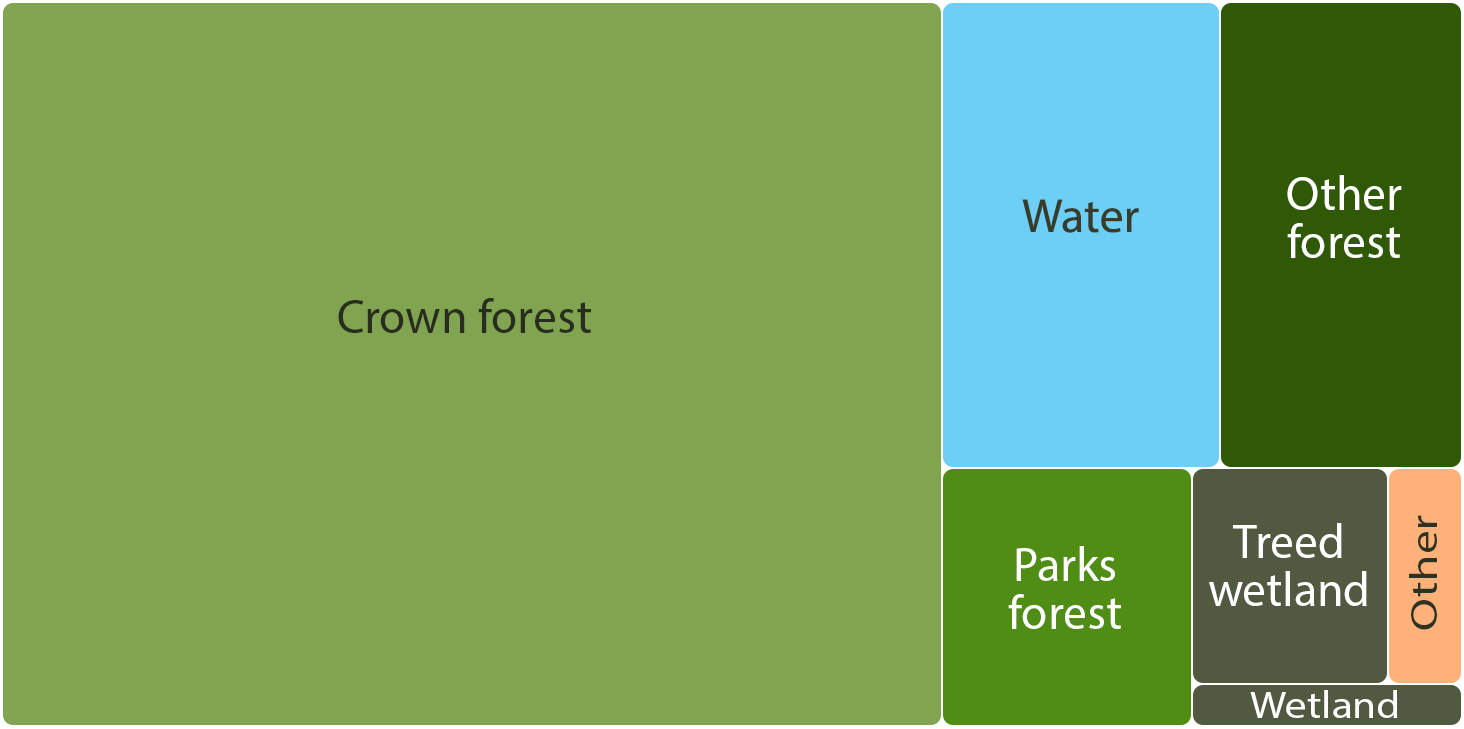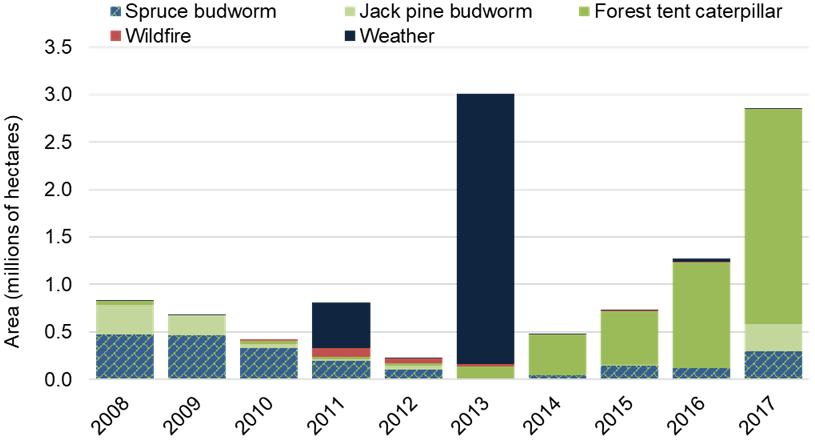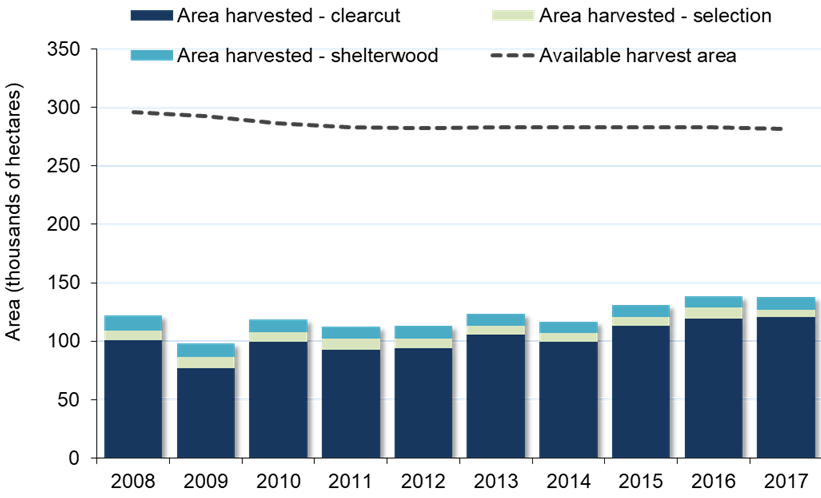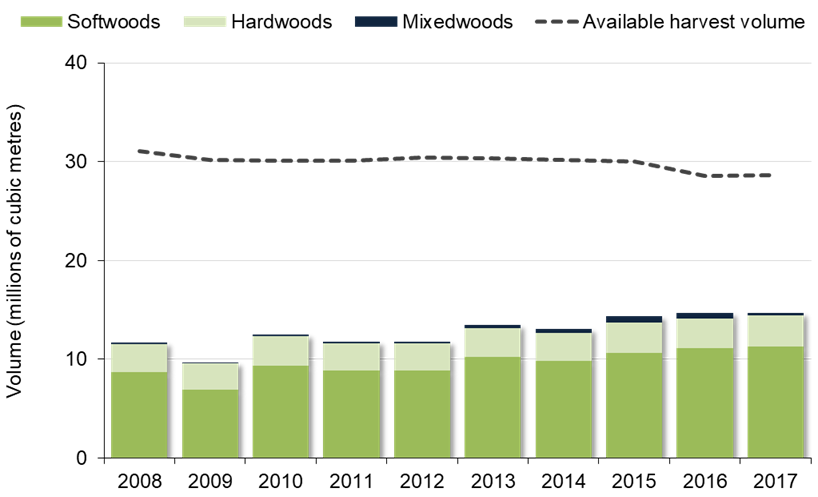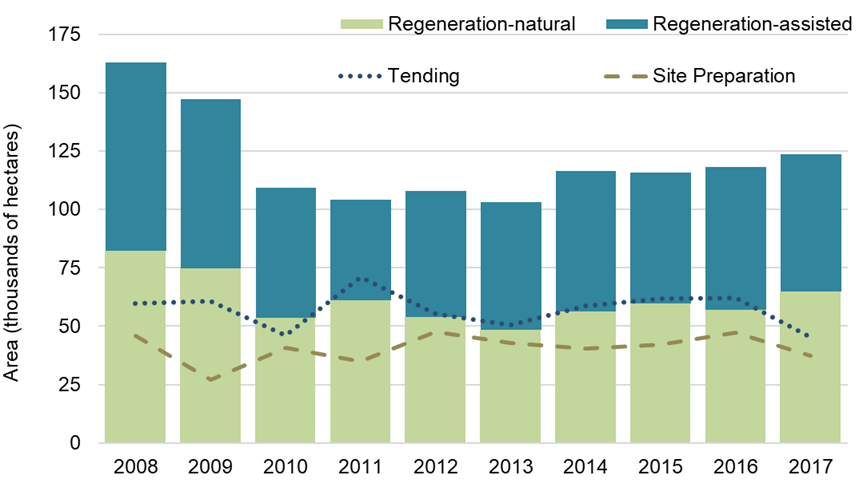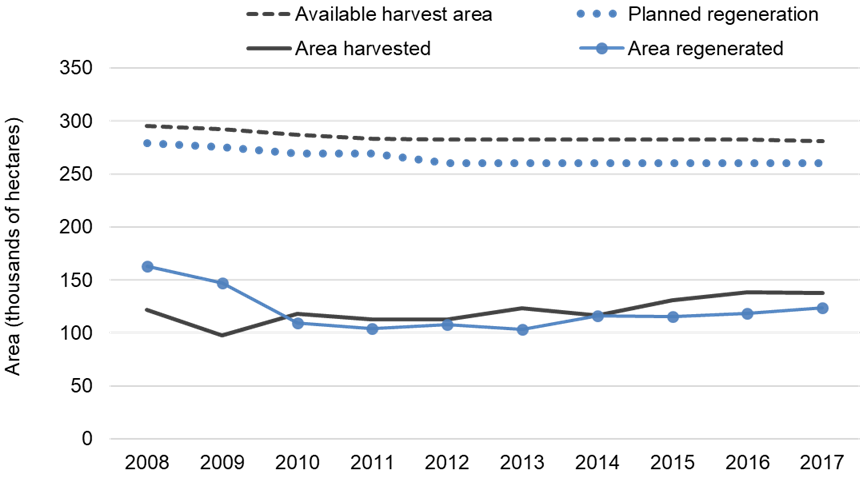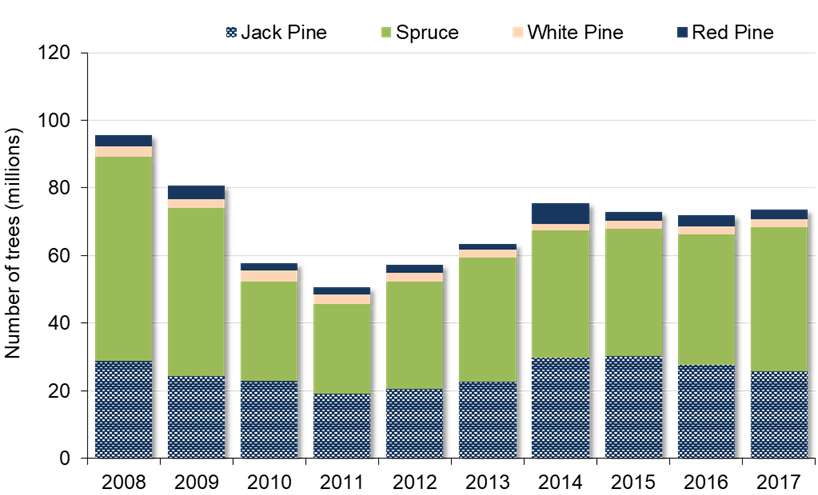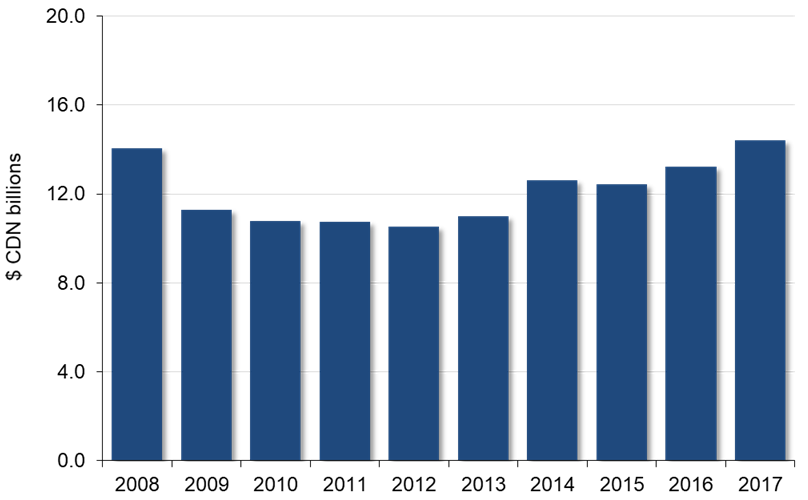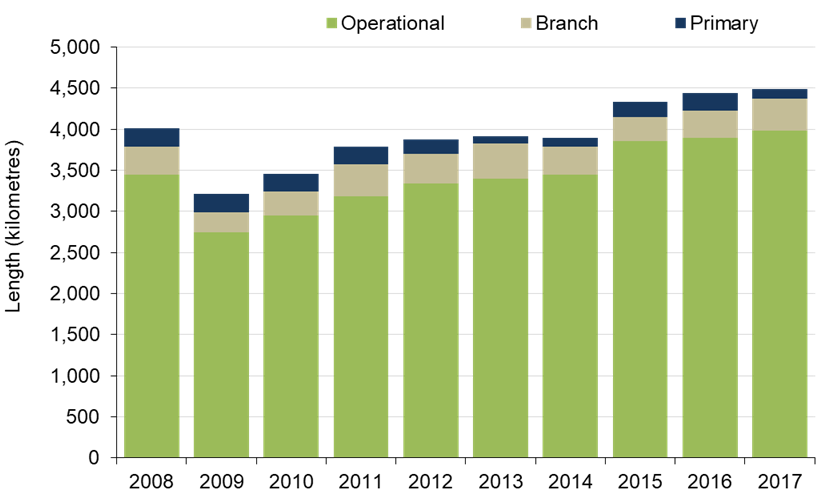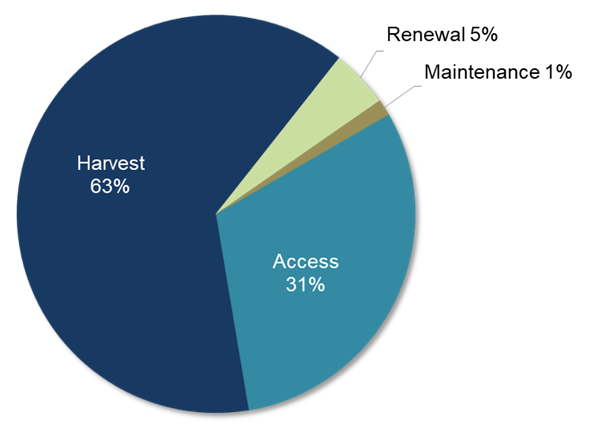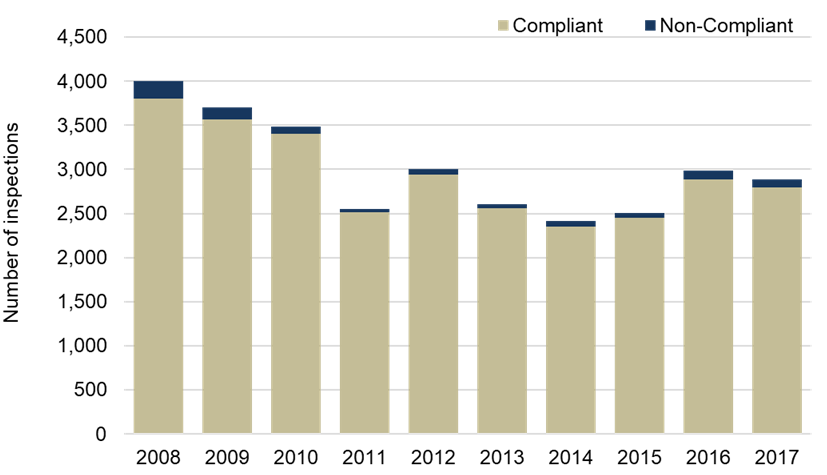Report on Forest Management 2016 and 2017
Read about how we managed publicly owned Crown forests in 2016 and 2017.
For the fiscal years:
- April 1, 2016 to March 31, 2017
- April 1, 2017 to March 31, 2018
Executive summary
Key forest management statistics within the Area of the Undertaking for fiscal years 2016 and 2017
| Metric | 2016 | 2017 |
|---|---|---|
| Area of natural disturbance (hectares) | 1,340,751 | 3,079,608 |
| Volume loss from natural disturbance (cubic metres) | 158,535 | 35,439 |
| Area harvested (hectares) | 138,243 | 137,427 |
| Volume of wood harvested (cubic metres) | 14,654,485 | 14,686,777 |
| Area regenerated (hectares) | 118,105 | 123,527 |
| Area regenerated artificially: tree planting and seeding (hectares) | 60,966 | 58,612 |
| Area regenerated naturally (hectares) | 57,139 | 64,915 |
| Proportion of surveyed area successfully regenerated (%) | 86% | 83% |
| Expenditures from the Forest Renewal Trust ($ CDN millions) | 52.3 | 51.4 |
| Contributions to the Forest Renewal Trust ($ CDN millions) | 53.7 | 49.8 |
| Forest industry revenues ($ CDN billions) | 13.2 | 14.4 |
| Crown charge payments for wood harvested ($ CDN millions) | 113.3 | 109.0 |
| Forest industry employment (number of direct jobs) | 49,500 | 46,100 |
| Forest access roads constructed (kilometres) | 4,444 | 4,492 |
| Forest access roads physically decommissioned (kilometres) | 418 | 903 |
| Number of forest operations inspection reports | 2,985 | 2,884 |
| Compliance rate of forest operations inspections (%) | 97% | 97% |
| Forest audits conducted | 12 | 12 |
| Proportion of audits recommending licence extensions (%) (excludes Crown units) | 100% | 100% |
| Forest management plans approved | 7 | 3 |
| Forest management plan amendments approved | 150 | 192 |
Introduction
The Crown Forest Sustainability Act regulates the harvest and renewal of Ontario's forests. The purpose of the act is to ensure the long-term health of Crown forests while meeting the social, economic and environmental needs of present and future generations (e.g. timber and commercial products, wildlife habitat and recreational opportunities, water filtration and carbon storage).
Forest management in Ontario is also subject to the Environmental Assessment Act. The ministry has authorization under this act (Declaration Order MNR-75) to conduct forest management on Crown lands in Central and Northern Ontario.
This report addresses the legal requirements outlined in the Environmental Assessment Requirements for Forest Management on Crown Lands in Ontario (Declaration Order MNR-75). It is also prepared consistent with the principles and intent of the Crown Forest Sustainability Act.
Since 1994 these reports have been prepared annually; however, all future reports will be prepared every two years. Although this is the first report prepared on a biennial basis, it is the twentieth provincial report on forest management in Ontario.
The Area of the Undertaking is divided into administrative areas known as forest management units. There were 41 units in this reporting period.
Forest management activities on each unit are planned and approved through forest management plans. Forest managers report each year on the activities conducted in a management unit.
The data from management unit reports is consolidated into province wide statistics and presented in this report covering activities that occurred during the two-year period April 1, 2016 to March 31, 2018. It does not include private land or provincial parks.
View the official management unit annual reports on the Find a Forest Management Plan website at ontario.ca/forestplans. Find more information on Ontario’s forest programs at ontario.ca/forests.
Ontario’s managed Crown forest area
Ontario is 107.6 million hectares in size.
- 93.2 million hectares or 87% of the province is publicly owned.
- 71.1 million hectares or 66% of the province is forest.
Forest management on Crown land is practiced within the Area of the Undertaking, as defined by Declaration Order MNR-75.
The Area of the Undertaking stretches across Central and Northern Ontario from Kemptville to Red Lake and includes 45 million hectares of forest, water, wetland and other land categories. It encompasses:
- 42% of the province’s area
- 37.4 million hectares of forest which is 53% of the province’s forest
- 27.8 million hectares of Crown forest that is productive for forest management
- 41 administrative forest management units that range in size from 300 thousand to 3.6 million hectares
For trend information on the area, age and types of forest in the Area of the Undertaking read the forest indicator on ecosystem composition and structure at ontario.ca/forestindicators.
View maps and detailed statistics on the area and volume of common tree species in the Forest Resources of Ontario report at ontario.ca/forestreporting.
The Area of the Undertaking
Area of land categories and ownerships within the Area of the Undertaking (hectares)
| Land category | Crown | Protected areas | Other | Total |
|---|---|---|---|---|
| Water | 4,623,644 | 964,341 | 276,275 | 5,864,260 |
| Wetland | 296,676 | 73,119 | 97,938 | 467,734 |
| Field/agriculture | 13,725 | 1,777 | 580,291 | 595,793 |
| Other | 282,800 | 83,247 | 290,591 | 656,638 |
| Forest (treed wetland) | 1,403,805 | 190,239 | 182,483 | 1,776,527 |
| Forest (productive) | 27,793,559 | 3,245,657 | 4,578,838 | 35,618,055 |
| Total | 34,414,209 | 4,558,380 | 6,006,416 | 44,979,007 |
Table note: The above area is from The Forest Resources of Ontario 2016. The protected areas category includes area within proposed and existing federal and provincial protected areas except for the utilization zone of Algonquin Park. The other category includes private, federal and Indigenous land.
Land categories in the Area of the Undertaking
Natural disturbances
A natural forest disturbance is when trees are killed or damaged from wildland fire, insects, disease, or weather. While these disturbances are part of well-functioning forest ecosystems, in any given year, they alter the forest differently.
Not all disturbances have the same effect. Tree mortality and volume loss vary depending on the:
- Type of disturbance. Wildland fire and extreme weather will destroy trees and create higher tree mortality and volume loss. Insects and disease will damage trees and reduce their growth, however may not result in significant mortality or volume loss. If insect or disease infestations recur over several years, it can affect tree survival.
- Type of forest where the disturbance occurs. Wildland fires in areas with young forest or minimal forest cover result in low mortality/volume loss.
The tables and charts below summarize the natural disturbances that occurred within Area of the Undertaking including the amount of Crown forest where mortality occurred and the resulting volume loss.
- The area disturbed increased across the Area of the Undertaking; however, volume loss remained low.
- Although the amount of disturbance increased in 2016 and 2017, levels were within the expected range of variation.
- Insects were the predominant type of disturbance.
- Natural disturbances from wildfire and weather remained low across the Area of the Undertaking.
- Wildfires occurred in areas with young forest or minimal forest cover resulting in low volume loss.
- While the area disturbed by forest tent caterpillar increased to over 2.2 million hectares, it did not result in volume losses from mortality.
- Jack pine budworm levels increased but no there were no volume losses from mortality.
- Spruce budworm levels continued to increase but volume losses remained low at 4,693 cubic metres in 2017.
For province wide trend information on natural disturbances, read the forest indicators on wildland fire, weather, native insects and disease and invasive insects and disease at ontario.ca/forestindicators.
Read the annual Forest Health Conditions report at ontario.ca/forestreporting for more detail on specific forest insects and diseases. Find current forest fire conditions in Ontario at ontario.ca/forestfire.
Area of forest where disturbance occurred within the Area of the Undertaking (hectares)
| Disturbance type | 2016 | 2017 |
|---|---|---|
| Spruce budworm | 119,318 | 294,190 |
| Jack pine budworm | 3,385 | 287,691 |
| Forest tent caterpillar | 1,104,542 | 2,266,777 |
| Poplar/birch complex | 45,173 | 204,050 |
| Other insects | 24,618 | 21,224 |
| Other diseases | none | 1,393 |
| Wildfire | 10,997 | 2,420 |
| Weather | 32,716 | 1,863 |
| Total | 1,340,751 | 3,079,608 |
Table note: The weather disturbance type includes drought, blowdown, frost, and winter browning. This is the gross area within which disturbance occurred including all severities of disturbance, all forest and ownership categories within the Area of the Undertaking.
Area of Crown forest where mortality occurred and resulting volume loss within the Area of the Undertaking
| Disturbance type | Area in 2016 (hectares) | Volume loss in 2016 (cubic metres) | Area of in 2017 (hectares) | Volume loss in 2017 (cubic metres) |
|---|---|---|---|---|
| Spruce budworm | 863 | 3,559 | 296 | 4,693 |
| Jack pine budworm | none | none | none | none |
| Forest tent caterpillar | none | none | none | none |
| Poplar/birch complex | none | none | none | none |
| Other insects | none | none | none | none |
| Other diseases | none | none | none | none |
| Wildfire | none | none | 979 | 6,164 |
| Weather | 7,107 | 154,976 | 1,028 | 24,582 |
| Total | 7,970 | 158,535 | 2,302 | 35,439 |
Table note: the area of mortality and volume loss are from Crown forest within the Area of the Undertaking only.
Forest area where natural disturbance occurred within the Area of the Undertaking from 2008-2017
Volume loss from mortality caused by natural disturbance in the Area of the Undertaking from 2008-2017
Harvest area and volume
The sustainable harvest of our forests provides renewable resources including lumber, structural board, pulp, paper, newsprint, bio‐fuel and textiles. Forest managers report on the area and volume harvested each year.
The tables and charts below summarize the available and actual area and volume harvested within the Area of the Undertaking. The available harvest area and volume are prescribed in approved forest management plans.
- Area and volume harvested increased slightly from the previous 5-year average but remained well below historic levels.
- 49% of the available area and 51% of the available volume was harvested (2-year average).
- 86% of the area was harvested under the clearcut silviculture system, 8% under the shelterwood system; and 6% was harvested using selection system (2-year averages).
- Most of the wood harvested was spruce, jack pine and poplar.
- Most of the volume flowed to sawmill, pulp and composite sectors.
- The decline in pulp volume can be tied to the increase in sawmill volumes that began in 2013. The increase in sawmill volume provides a greater supply of wood chips and pulp and paper manufacturers prefer to purchase wood chips to supply their mills rather than harvest pulpwood.
- The volume harvested for bioproducts decreased to below 300,000 cubic metres in 2017. This decrease is tied to the 2017 closure of a pellet mill in Wawa.
For provincial trend information, read the forest indicator on harvest area and the forest indicator on harvest volume at ontario.ca/forestindicators.
Read more about the silviculture systems used to harvest and renew forests.
Area available and harvested
| Measure | 2016 | 2017 |
|---|---|---|
| Available harvest area (hectares) | 282,876 | 281,403 |
| Area harvested (hectares) | 138,243 | 137,427 |
| Proportion of available area harvested (%) | 49% | 49% |
Area harvested by silviculture system (hectares)
| Silviculture system | 2016 | 2017 |
|---|---|---|
| Clearcut | 119,507 | 120,737 |
| Selection | 9,160 | 6,188 |
| Shelterwood | 9,576 | 10,502 |
| Total all systems | 138,243 | 137,427 |
Volume available and harvested
| Measure | 2016 | 2017 |
|---|---|---|
| Available harvest volume (cubic metres) | 28,577,136 | 28,617,898 |
| Volume harvested (cubic metres) | 14,654,485 | 14,686,777 |
| Proportion of available volume harvested (%) | 51% | 51% |
Volume harvested by tree species group (cubic metres)
| Species | 2016 | 2017 |
|---|---|---|
| Softwoods | 11,115,582 | 11,265,843 |
| Hardwoods | 3,014,855 | 3,129,847 |
| Mixedwood | 524,048 | 291,088 |
| Total volume | 14,654,485 | 14,686,777 |
Volume harvested by tree species (cubic metres)
| Tree species | 2016 | 2017 |
|---|---|---|
| White pine | 374,609 | 396,285 |
| Red pine | 188,188 | 209,182 |
| Jack pine | 3,865,697 | 3,969,955 |
| Spruce | 6,109,522 | 6,147,912 |
| Balsam fir | 510,891 | 499,720 |
| Other softwood | 66,675 | 42,788 |
| Poplar | 2,165,839 | 2,340,008 |
| White birch | 272,473 | 281,801 |
| Maple | 465,533 | 394,249 |
| Oak | 34,660 | 41,525 |
| Yellow birch | 30,249 | 35,818 |
| Other hardwood | 46,102 | 36,447 |
| Mixedwood | 524,048 | 291,088 |
Volume harvested by product sector (cubic metres)
| Product type | 2016 | 2017 |
|---|---|---|
| Paper | 193,240 | 118,861 |
| Pulp | 3,131,188 | 2,693,178 |
| Sawmill | 8,806,874 | 9,381,039 |
| Veneer | 222,628 | 280,556 |
| Composite | 1,605,818 | 1,738,473 |
| Bioproduct | 526,695 | 291,088 |
| Commercial fuelwood | 155,248 | 143,613 |
| Other | 12,794 | 39,968 |
Area available and area harvested by silviculture system from 2008-2017
Volume available and volume harvested by tree species group from 2008-2017
Forest renewal
Forest renewal includes the silviculture operations used to establish and grow back the forest after harvesting. Renewal activities include site preparation, natural or assisted regeneration and tending.
Tending activities may be required to improve the survival, growth and quality of a regenerating forest. Protection operations manage or prevent damage from forest insects and disease.
For every cubic metre of wood harvested, forest managers contribute money to the Forest Renewal Trust to ensure there are enough funds available to regenerate harvested areas.
The tables and charts below summarize the planned and actual level of renewal activities within the Area of the Undertaking. Planned levels are based on projected activities in approved forest management plans and reflect planned levels of harvest.
The amount of area actually renewed is based on the amount of area that is harvested. This means that planned renewal levels cannot be directly compared to the actual renewal. In 2016 and 2017 both the area harvested and renewed were less than planned (see chart Area of planned and actual regeneration and harvest from 2008-2017).
- The level of renewal and tending activity increased slightly from the previous 5-year average.
- Regeneration, site preparation and tending activity averaged 44% of planned levels (2-year average). This is consistent with the level of area harvested which was 49% of the available area.
- Natural regeneration was used for 50% and assisted regeneration was used for 50% of the area renewed (2-year average).
- Tree planting was the main method of assisted regeneration. 55% of the trees planted were spruce and 36% were jack pine (2-year average).
- There were no protection operations (also known as forest pest management programs).
- Forest managers spent $56 million per year renewing forests across the province (2-year average).
- Forest managers contributed $3.66 per cubic metre to the Forest Renewal Trust in 2016 and $3.39 per cubic metre in 2017.
Read more about forest renewal, methods of natural and assisted regeneration, and the silviculture systems used to renew forests.
Area renewed, tended and protected (hectares)
| Activity | 2016 | 2017 |
|---|---|---|
| Regeneration | 118,105 | 123,527 |
| Site preparation | 47,067 | 37,271 |
| Tending | 62,070 | 45,439 |
| Protection (pest control) | 0 | 0 |
Area of actual and planned renewal and tending (hectares)
| Measure | Regeneration | Site preparation | Tending |
|---|---|---|---|
| Planned area in 2016 (hectares) | 260,348 | 105,459 | 114,190 |
| Area treated in 2016 (hectares) | 118,105 | 47,067 | 62,070 |
| Proportion of planned in 2016 (%) | 45% | 45% | 54% |
| Planned area in 2017 (hectares) | 260,348 | 105,459 | 114,190 |
| Area treated in 2017 (hectares) | 123,527 | 37,271 | 45,439 |
| Proportion of planned in 2017 (%) | 47% | 35% | 40% |
Expenditures on renewal, tending and protection ($ CDN millions)
| Activity | 2016 | 2017 |
|---|---|---|
| Natural regeneration | 1.7 | 0.6 |
| Tree Marking | 0 | 1.9 |
| Assisted regeneration | 17.8 | 17.4 |
| Site preparation | 10.0 | 9.1 |
| Tending | 9.7 | 6.9 |
| Renewal support | 10.8 | 11.6 |
| Silvicultural Survey | 0 | 0.9 |
| Other eligible activities | 7.3 | 6.1 |
| Protection (insect pest control) | 0 | 0 |
Table note: renewal support includes activities like cone collection and transport, seed extraction, storage, testing and transport, tree improvement and seedling purchase and delivery. Other eligible activities may include administrative overhead silviculture wages and expenses. Reported expenditures may include costs for some activities conducted in previous years.
Area renewed - natural regeneration (hectares)
| Method | 2016 | 2017 |
|---|---|---|
| Clearcut silviculture system | 43,531 | 55,194 |
| Shelterwood silviculture system | 4,448 | 3,534 |
| Selection silviculture system | 9,160 | 6,188 |
| Total natural regeneration | 57,139 | 64,915 |
Area renewed - assisted regeneration (hectares)
| Method | 2016 | 2017 |
|---|---|---|
| Tree planting | 48,420 | 48,670 |
| Seeding | 12,546 | 9,941 |
| Total assisted regeneration | 60,966 | 58,612 |
Number of trees and seeds used (millions)
| Type | 2016 | 2017 |
|---|---|---|
| Trees | 72.1 | 73.5 |
| Seeds | 415.2 | 394.6 |
Number of trees planted by species (millions)
| Species | 2016 | 2017 |
|---|---|---|
| Spruce | 38.5 | 42.7 |
| Jack Pine | 27.7 | 25.7 |
| Red Pine | 3.4 | 2.7 |
| White Pine | 2.4 | 2.3 |
| Other | 0.071 | 0.005 |
| Total trees planted | 72.1 | 73.5 |
Contributions and expenditures to forest trusts ($ CDN millions)
| Fund | Contributions in 2016 | Expenditures in 2016 | Contributions in 2017 | Expenditures in 2017 |
|---|---|---|---|---|
| Forest Renewal Trust Fund | 53.7 | 52.3 | 49.8 | 51.4 |
| Forestry Futures Trust Fund | 21.7 | 15.4 | 20.3 | 14.2 |
Area of renewal activities from 2008-2017
Area of planned and actual regeneration and harvest from 2008-2017
Tree species planted from 2008-2017
Contributions and expenditures to the Forest Renewal Trust from 2008-2017
Monitoring forest renewal
Ontario’s forest managers conduct surveys to assess the status of regenerating forest areas.
If an area has regenerated successfully, it is classified as free-to-grow. This means that the regenerating trees meet the stocking, height and growth rate targets and are deemed to be healthy and free from competing vegetation.
However, it does not mean that the area has met its targeted forest type. Areas that also achieve the planned forest type are classified as a silviculture success.
It can take 15 years or more after harvest for renewed areas to be successfully regenerated. Forest managers may determine that additional tending, treatment or time is required before some surveyed areas are considered free-to-grow.
The table and chart below summarize the survey results within the Area of the Undertaking. Percentages compare regeneration and silviculture success to the total area surveyed for that year.
- Results showed that 84% of the area surveyed was regenerated successfully (2-year average).
- Forest managers determined that 58% of the area surveyed was a silviculture success (2-year average).
Updated planning requirements will change how regeneration is monitored beginning with year 2020 forest management plans. This may alter how the status of regenerating areas is reported in the future.
For provincial trend information, read the forest indicator on forest regeneration at ontario.ca/forestindicators.
Status of regenerating areas surveyed
| Measure | 2016 | 2017 |
|---|---|---|
| Total area surveyed (hectares) | 175,479 | 102,257 |
| Area free-to-grow (hectares) | 150,920 | 84,847 |
| Proportion free-to-grow (%) | 86% | 83% |
| Area free-to-grow to target forest type: silviculture success (hectares) | 109,027 | 54,955 |
| Proportion free-to-grow to target forest type: silviculture success (%) | 62% | 54% |
Table note: percentages compare regeneration and silviculture success to the total area surveyed for that year.
Status of regenerating areas surveyed from 2008-2017
Forest industry
The sustainable harvest of renewable forest products by the forest industry provides social and economic benefits to Ontarians.
Harvesting trees from Crown forests requires a licence and payment of fees (Crown timber charges) for every cubic metre of wood harvested.
The tables and charts below summarize the forest industry statistics for employment, Crown timber charges, and active forest licences.
- The forest sector averaged of 47,800 direct jobs in 2016 and 2017.
- The decline in employment from 2016 to 2017 was in the forestry and logging industry and the pulp and paper product manufacturing industry.
- The forest sector’s revenue from goods manufactured increased reaching $14.4 billion in 2017.
- Licence levels declined slightly with fewer active forest resource licenses.
- Crown timber charge payments averaged $111.2 million per year.
For provincial trend information, read the forest indicators on forest employment and stumpage at ontario.ca/forestindicators.
Read more about the different types of forest licences.
Forest sector employment and revenue
| Measure | 2016 | 2017 |
|---|---|---|
| Direct employment (number of jobs) | 49,500 | 46,100 |
| Revenue from goods manufactured ($ CDN billions) | 13.2 | 14.4 |
Table notes: the data source for direct employment has changed from previous reports and will result in inconsistencies when comparing this report to previous reports. Revenue and employment information is sourced from published Statistics Canada data. Employment is estimated through Statistics Canadas’ Labour Force Survey. Previously reported employment for 2014 and 2015 is revised to 50,900 and 47,300 respectively. The revenue from goods manufactured includes forestry and logging industry, pulp and paper product manufacturing industry, and wood product manufacturing industry.
Forest sector total revenue from goods manufactured from 2008-2017
Number of forest licences
| Type of licence | 2016 | 2017 |
|---|---|---|
| Sustainable forest licences | 31 | 30 |
| Commercial forest resource licences | 621 | 541 |
| Non-commercial forest resource licences | 2,766 | 2,550 |
| Total | 3,418 | 3,121 |
Crown timber charges paid ($ CDN millions)
| Crown timber charge type | 2016 | 2017 |
|---|---|---|
| Forestry futures charge paid into the Forestry Futures Trust | 21.7 | 20.3 |
| Forest renewal charge paid into the Forest Renewal Trust | 53.7 | 49.8 |
| Stumpage paid into the Consolidated Revenue Fund | 37.9 | 38.9 |
| Total charges paid | 113.3 | 109.0 |
Forest access roads
Forest managers report annually on forest access road construction, maintenance, abandonment, and controls. The tables and charts below summarize the amount of forest roads subject to each activity within the Area of the Undertaking.
- Consistent with the long-term trend, most of the road construction was for operational roads while most of the road maintenance was for primary roads.
- More access controls were established using signage than gates or barriers.
- Most of the physical road decommissioning was for operational roads.
For provincial trend information, read the forest indicator on access roads at ontario.ca/forestindicators.
Read more about forest roads funding.
Length of forest roads constructed (kilometres)
| Road class | 2016 | 2017 |
|---|---|---|
| Primary | 213 | 118 |
| Branch | 337 | 388 |
| Operational | 3,894 | 3,986 |
| Total | 4,444 | 4,492 |
Length of forest roads maintained (kilometres)
| Road class | 2016 | 2017 |
|---|---|---|
| Primary | 14,886 | 15,384 |
| Branch | 5,276 | 4,687 |
| Operational and Existing | 8,778 | 6,695 |
| Total | 28,940 | 26,765 |
Length of forest roads with access controls established (kilometres)
| Control method | 2016 | 2017 |
|---|---|---|
| Signage | 3,009 | 864 |
| Gate/Barrier | 1,481 | 824 |
| Total | 4,490 | 1,688 |
Length of forest roads physically decommissioned (kilometres)
| Road class | 2016 | 2017 |
|---|---|---|
| Primary | 0 | 29 |
| Branch | 9 | 32 |
| Operational | 409 | 842 |
| Total | 418 | 903 |
Table note: the data reported no longer includes natural road decommissioning. This may create inconsistencies if comparing to previous reports.
Forest road construction by road class from 2008-2017
Forest operations compliance
Compliance inspections determine if forest operations on Crown lands are following applicable rules and approved plans. Forest operations monitored for compliance include timber harvesting, road construction, water crossings and forest renewal.
Compliance monitoring occurs in partnership between the Ministry of Natural Resources and the forest industry.
The tables and charts below summarize the results of compliance monitoring within the Area of the Undertaking.
- Inspections by the ministry and industry across all operations had an average compliance rate of 97% for 2016 and 2017.
- The proportion of inspections undertaken by industry and the ministry was consistent with previous years.
- Most inspection were related to access and harvesting and operations.
- Most of the remedy and enforcement actions applied were written warnings.
For provincial trend information, read the forest indicator on operations compliance at ontario.ca/forestindicators.
Number of compliance inspections by inspector type
| Inspector type | 2016 | 2017 |
|---|---|---|
| Ministry | 600 | 677 |
| Forest industry | 2,385 | 2,207 |
| Total | 2,985 | 2,884 |
Compliance inspection results by inspector type (number of inspections)
| Inspector type and result | 2016 | 2017 |
|---|---|---|
| Ministry: compliant | 560 | 640 |
| Ministry: non-compliant | 40 | 37 |
| Forest industry: compliant | 2,325 | 2,159 |
| Forest industry: non-compliant | 60 | 48 |
Compliance inspections results by operation type (number of inspections)
| Operation type | Compliant in 2016 | Non-compliant in 2016 | Compliant in 2017 | Non-compliant in 2017 |
|---|---|---|---|---|
| Access | 867 | 36 | 881 | 17 |
| Harvest | 1,840 | 63 | 1,747 | 64 |
| Renewal | 141 | 1 | 131 | 3 |
| Maintenance | 37 | none | 40 | 1 |
| Total | 2,885 | 100 | 2,799 | 85 |
Number and value of remedy and enforcement actions by action type
| Action type | Number in 2016 | Value in 2016 ($ CDN) | Number in 2017 | Value in 2017 ($ CDN) |
|---|---|---|---|---|
| Written warning | 43 | 0 | 86 | 0 |
| Order - stop/limit/amend | 0 | 0 | 1 | 0 |
| Order - repair | 2 | 0 | 4 | 0 |
| Order - compliance | 6 | 0 | 16 | 0 |
| Administrative penalty (paid into the Forestry Futures Trust) | 13 | 38,269 | 14 | 42,634 |
| Offence charge (paid into the Consolidated Revenue Fund) | 0 | 0 | 0 | 0 |
| License suspension and cancellation | 0 | 0 | 0 | 0 |
| Total | 64 | 38,269 | 121 | 42,634 |
Compliance inspections by operation type in 2016 and 2017 (average)
Compliance inspection results from 2008-2017
Independent forest audits
Independent forest audits are conducted on all Crown forests at least once every 5-7 years. An independent auditor assesses the performance of both the sustainable forest licence holder and the Ministry of Natural Resources in meeting their forest management responsibilities.
Audits may conclude that a forest is being managed:
- in compliance with the legislation, policies and the principles of sustainable forest management
- in compliance but with critical noted exceptions or conditions
- not in compliance
Forest managers must address any exceptions or conditions to bring management of the forest into full compliance with all requirements.
The table below summarizes the results of the independent forest audits conducted in 2016 and 2017 by management unit.
- Results were generally positive, with most audits concluded that the forests were managed in compliance with legislation, policy and licence requirements, and with the principles of sustainable forest management.
- The Armstrong portion of the Lake Nipigon Forest was found not to be in full compliance; however, the audit team concluded that forest sustainability was not threatened in the short term.
- The Magpie Forest was found not to be in full compliance. The sustainable forest licence holder’s bankruptcy and the transition of management responsibility to the ministry created challenges in delivering the forest management program.
- All forests received licence extension recommendations, where applicable. The licence extension recommendation does not apply to Crown units; however, on the Pic River Forest it was recommended that a sustainable forest licence be issued.
- Some of the exceptions and conditions noted included: remediating water crossings with safety concerns, revising the forest compliance plan, maintaining the Forest Renewal Trust account minimum balance, ensuring consistency between the Annual Work Schedule and the Forest Management Plan, monitoring forest renewal, completing recommendations from previous audits.
For provincial trend information, read the forest indicator on independent forest audits at ontario.ca/forestindicators.
View the audit reports for each management unit.
Independent forest audit results
| Year of audit | Management unit | In compliance | Sustainable Forest Licence extension recommended by auditor |
|---|---|---|---|
| 2016 | Algoma Forest | Yes, with exceptions | Yes, with conditions |
| 2016 | French-Severn Forest | Yes | Yes |
| 2016 | Gordon Cosens Forest | Yes | Yes |
| 2016 | Lake Nipigon Forest | Yes: Nipigon east portion No: Armstrong portion | Yes |
| 2016 | Magpie Forest | No | not applicable - Crown unit |
| 2016 | Mazinaw-Lanark Forest | Yes | Yes |
| 2016 | Nipissing Forest | Yes | Yes |
| 2016 | Pic River Forest | Yes | not applicable - Crown unit - recommended issuance |
| 2016 | Spanish Forest | Yes | Yes |
| 2016 | Sudbury Forest | Yes | Yes |
| 2016 | Temagami Forest | Yes, with exceptions | not applicable - Crown unit |
| 2016 | Timiskaming Forest | Yes | Yes |
| 2017 | Abitibi River Forest | Yes | Yes |
| 2017 | Algonquin Park Forest | Yes | Yes |
| 2017 | Bancroft-Minden Forest | Yes | Yes |
| 2017 | Black Spruce Forest | Yes | Yes |
| 2017 | Crossroute Forest | Yes | Yes |
| 2017 | Lac Seul Forest | Yes | Yes |
| 2017 | Martel Forest | Yes | Yes |
| 2017 | Nagagami Forest | Yes | Yes |
| 2017 | Northshore Forest | Yes | Yes |
| 2017 | Ogoki Forest | Yes, with exceptions | not applicable - Crown unit |
| 2017 | Pineland Forest | Yes | Yes |
| 2017 | Sapawe Forest | Yes | Yes |
Table note: in compliance means generally managed in compliance with the legislation and policies that were in effect during the audit period, as well as with the principles of sustainable forest management.
Forest management planning implementation
Before any forestry activities can take place, a forest management plan must be in place. Preparing and implementing a forest management plan is a rigorous process that engages the public, stakeholders, and Indigenous communities at various stages.
Forest managers report each year on the forest management activities conducted in a management unit.
The tables and charts below summarize the implementation of the forest management planning in 2016 and 2017 including plan approvals, amendments, issues raised during planning, and annual report submissions.
- Four forest management plans and 6 contingency plans were approved. Three of the 4 forest management plans approved were phase II operational plans. Approved amendments were mostly administrative (98%) and the majority related to forest access roads and harvest areas.
- The issues raised during public and indigenous consultation included: harvest, and aesthetics.
- The issue resolution process was initiated for about 25% of the forest management plans.
- Interested parties submitted 2 individual environmental assessment requests to the Ministry of Environment, Conservation and Parks for 1 forest management plan. No requests were granted; however, additional conditions were imposed on the Abitibi River plan.
- In both years, all 41 management unit annual reports were submitted.
Read more about forest management planning.
View the forest management unit map and the renewal schedule for forest management plans.
Find the official forest management plans on the Find a Forest Management Plan website at ontario.ca/forestplans.
Number of forest management plans approved
| Plan type | 2016 | 2017 |
|---|---|---|
| Forest management plans | 3 | 1 |
| Contingency plans | 4 | 2 |
| Total | 7 | 3 |
Number of forest management plan amendments approved
| Category of amendment | 2016 | 2017 |
|---|---|---|
| Administrative | 147 | 187 |
| Major | 0 | 0 |
| Minor | 3 | 5 |
| Total | 150 | 192 |
Individual environmental assessment requests
| Year of request | Forest management plan | Number of requests | Number granted | Nature of the request |
|---|---|---|---|---|
| 2016 | Abitibi River | 2 | 0 | Concerns from an Indigenous community regarding impacts to Aboriginal and treaty rights, trapping grounds and traditional lands. Concerns regarding hydrological impacts and impacts on recreation, aesthetics, and wildlife habitat. |
Table note: The individual environmental assessment requests for the Abitibi River plan were denied with conditions.
Indigenous people’s participation in the benefits from forest management
Declaration Order MNR-75 requires district managers to conduct negotiations at the local level with Indigenous communities. These negotiations identify and implement ways of achieving more equal participation by Indigenous peoples in the benefits provided through forest management.
Forest management activities can provide local opportunities for employment and business development. The involvement and participation of Indigenous communities, the forest industry, and other government bodies is critical to the success in providing these opportunities.
Arrangements and agreements take different forms to meet the unique needs, capacities, and situations of individual Indigenous communities. They may involve entire communities, individual community members or businesses. Local forest-based economic opportunities may include:
- forest harvesting licenses or contracts
- silviculture contracts for growing nursery stock, planting trees, seeding, tending, and site preparation
- contracts for other forest management activities such as wood hauling and road maintenance or construction
- forestry related training and development
In 2016, some of the results of ministry and Indigenous communities’ discussions included:
- Thunder Bay District: contracts for bridge and road decommissioning and road maintenance.
- Kenora District: licenses for harvesting approximately 127,000 cubic metres and contracts for burning slash and road maintenance.
- Nipigon District: licenses for harvesting approximately 166,000 cubic metres.
In 2017, some of the results of ministry and Indigenous communities’ discussions included:
- Kirkland Lake District: contract for tending 500 hectares.
- Sault Ste. Marie District: contacts for producing 357,000 seedlings, collecting 14 hectolitres of cones and tending 100 hectares.
- Wawa District: license for harvesting approximately 2,800 cubic metres.
- Kenora District: licenses for harvesting approximately 351,000 cubic metres and contracts for burning slash and road maintenance.
- Nipigon District: licenses for harvesting 280,000 cubic metres.
- Sioux Lookout District: license for harvesting approximately 100,000 cubic metres, and contracts for cone collection, tree planting, and road maintenance.
Indigenous people have been active participants and are increasingly interested in being involved in forest management and the forest sector.
For provincial trend information, read the forest indicator on forest harvest by Indigenous people at ontario.ca/forestindicators.
Conclusion
This report has provided key information on sustainable forest management activities within the Area of the Undertaking.
The next report will be prepared in 2021 covering activities from April 1, 2018 to March 31, 2020.
Find out more about forestry and forest management in Ontario by visiting our forestry webpage at ontario.ca/forests or by reading other reports at ontario.ca/forestreporting.
Ministry of Natural Resources
Crown Forests and Lands Policy Branch
Forest Sustainability and Information Section
ISSN 1703-8332 (Online) – English
Recommended citation: Ontario Ministry of Natural Resources and Forestry. 2020. Report on Forest Management 2016 and 2017.

